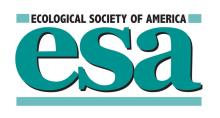Resource information
Global trends in pollinatorâdependent crops have raised awareness of the need to support managed and wild bee populations to ensure sustainable crop production. Provision of sufficient forage resources is a key element for promoting bee populations within human impacted landscapes, particularly those in agricultural lands where demand for pollination service is high and land use and management practices have reduced available flowering resources. Recent government incentives in North America and Europe support the planting of wildflowers to benefit pollinators; surprisingly, in North America there has been almost no rigorous testing of the performance of wildflower mixes, or their ability to support wild bee abundance and diversity. We tested different wildflower mixes in a spatially replicated, multiyear study in three regions of North America where production of pollinatorâdependent crops is high: Florida, Michigan, and California. In each region, we quantified flowering among wildflower mixes composed of annual and perennial species, and with high and low relative diversity. We measured the abundance and species richness of wild bees, honey bees, and syrphid flies at each mix over two seasons. In each region, some but not all wildflower mixes provided significantly greater floral display area than unmanaged weedy control plots. Mixes also attracted greater abundance and richness of wild bees, although the identity of best mixes varied among regions. By partitioning floral display size from mix identity we show the importance of display size for attracting abundant and diverse wild bees. Seasonâlong monitoring also revealed that designing mixes to provide continuous bloom throughout the growing season is critical to supporting the greatest pollinator species richness. Contrary to expectation, perennials bloomed in their first season, and complementarity in attraction of pollinators among annuals and perennials suggests that inclusion of functionally diverse species may provide the greatest benefit. Wildflower mixes may be particularly important for providing resources for some taxa, such as bumble bees, which are known to be in decline in several regions of North America. No mix consistently attained the full diversity that was planted. Further study is needed on how to achieve the desired floral display and diversity from seed mixes.



